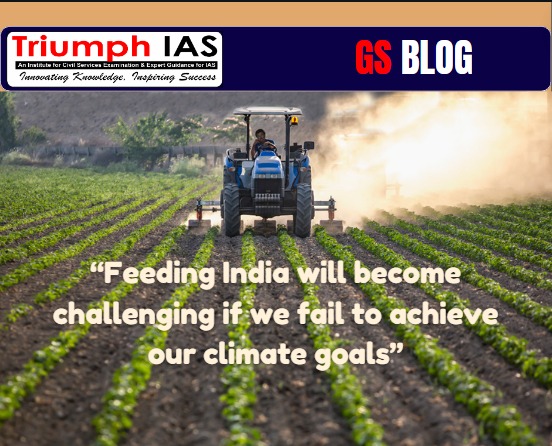“Feeding India will become challenging if we fail to achieve our climate goals “
India’s agricultural industry, employing almost half of the nation’s workforce and making a significant contribution to the GDP, is confronted with the dual issue of being impacted by climate change and also being a major emitter of greenhouse gases.
India’s agriculture sector faces a critical dual challenge: it is both a victim of climate change and a significant greenhouse gas (GHG) emitter. Let’s delve into some key points:
- GHG Emissions from Agriculture:
- According to India’s Third Biennial Update Report submitted to the United Nations Framework Convention on Climate Change (UNFCCC), the agriculture sector contributes 14% of the country’s total GHG emissions.
- Within the sector, specific activities contribute to emissions:
- Enteric Fermentation: 54.6% of GHG emissions result from enteric fermentation (digestive processes in livestock).
- Rice Cultivation: 17.5% of emissions come from rice cultivation.
- Fertilizer Application: 19.1% of emissions arise from fertilizer use on agricultural soils.
- Manure Management: 6.7% of emissions are due to managing animal manure.
- Field Burning: 2.2% of emissions occur from burning agricultural residues in fields.

- India’s Commitments and Challenges:
- During the 26th Conference of the Parties (CoP26), India made significant climate commitments:
- Reaching 500 gigawatts (GW) of non-fossil fuel energy capacity by 2030.
- Producing 50% of energy requirements from renewable sources by 2030.
- Reducing carbon emissions by 1 billion tonnes by 2030.
- Decreasing the carbon emission intensity of GDP by 45% by 2030.
- Achieving net-zero emissions by 2070.
- However, India’s rapid economic growth plans could lead to a 41% increase in GHG emissions by 2030. Balancing development with emission reduction remains a challenge.
- During the 26th Conference of the Parties (CoP26), India made significant climate commitments:
- Impact of Climate Change on Agriculture:
- Changing climate patterns threaten India’s agricultural growth:
- Frequent dry spells.
- Heat waves.
- Erratic rainfall.
- Sustainable adaptation and mitigation strategies are essential to safeguard the sector.
- Changing climate patterns threaten India’s agricultural growth:
Efforts to combat climate change in Indian agriculture are crucial for both environmental sustainability and food security. India’s existing Mission for Sustainable Agriculture (NMSA) aims to address climate change impacts in the sector, but continued innovation and policy implementation are necessary to achieve long-term resilience
Previous Year Question
Correct answer: 4) Forests (Forests are actually a significant carbon sink, absorbing CO2) 2) Discuss the role of agriculture in greenhouse gas emissions and the measures that can be taken to mitigate these emissions. (250 words) [UPSC 2019] |
Sociology Optional Program for
UPSC CSE 2025 & 2026
Follow us :
🔎 https://www.instagram.com/triumphias

